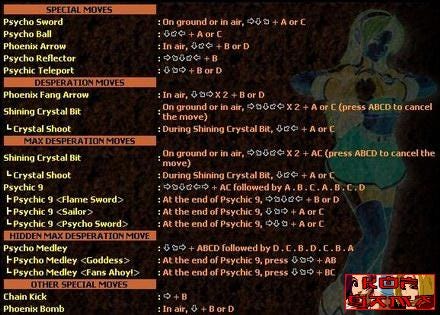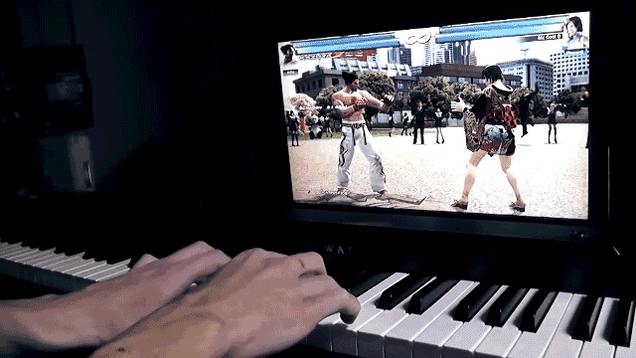
Featured Blog | This community-written post highlights the best of what the game industry has to offer. Read more like it on the Game Developer Blogs or learn how to Submit Your Own Blog Post
Thoughts on Fighting Game Difficulty and Casual
Lately, there's been discussion about modern fighting games and their efforts to attract more casual players. I believe there are many barriers that prevent this, but should all these barriers be eliminated entirely?

Fighting games are not easy. It's a simple truth. Whether it's because of complex inputs, even more complex systems, too much variety in play style or too many characters, the genre has a hard time attracting casual players without relying on brand.
After reading a few thoughts on fighting game tutorialization and various tweets discussing the issue, I decided to write my own thoughts. I want to go over what I think makes fighting games difficult right now and then what can be done to ease these difficults -- with some caveats as well.
What Makes Fighting Games Difficult?
There are a lot of things that make fighting games difficult, some of which have could be helped with tutorials, some not so much. I'm basing my thoughts on these on the concept of pick-up-and-play. What aspects of fighting games make them more difficult for a casual player to pick up and start playing and having fun without having played many (if any) fighters before.
Controls
The Problem
Though advanced command inputs such as quarter and half circles allow for more attacks with a limited number of buttons, the dexterity and motor skills required to perform these actions are not second nature for many. This can result in two frustrating scenerioes in which the player asks either "How did I do that?" -- performing a special move without knowing why or how it worked -- or, trying to learn the movement but not performing it correctly. Misinputs can be an exciting event while watching a professional match, but to a novice player, they usually result in confusion and frustration. With practice, these become second nature, but some, more casual players, will probably quit and move onto a new game before taking the time to learn the advanced input commands required by most of today's fighter. This is compounded by the fact that some fighters' inputs seem to be designed more for fightsticks than controllers, an accessory most casual players won't invest in.

The above move list, for example, is probably pretty confusing to someone who has never played a fighting game before.
Solutions
Tutorialization
One solution, which is its own problem I'll discuss later, is tutorializing moves list. A lot of modern fighting games have combo challenge modes that sometimes make players perform special attacks before moving onto more advanced combos. This is a great start, allowing players to get used to performing complex commands; however, I think a lot of games need to go even further with his explanation, starting with how to PHYSICALLY perform these moves. How exactly do the developers expect players to perform quarter circles -- the speed, accuracy, the motion, etc. Usually, new players learn this through a combiation of experimentation, past knowledge, and/or help from more skilled players. This can be rather frustrating though if you don't have those resources; the lack of said resources is probably something the prevents more casual players from really getting into fighting games.
The solution of tutorializig command move performance, however, is complicated: is the player using a pad? A fightstick? A hitbox? All different devices with their own way to perform moves or at least feel different, so the physical explanation of one doesn't really suffice for another.

How do you teach playing on a piano? You don't.
Simplicity
Another, a more realistic solution than the one previously states, is simplifying commands lists. I was happy to see a new fightign game, the short-lived, Rising Thunder, attempt this. Essentially, instead of using quarter and half or z motion, use simpler inputs -- forward + punch or back + kick. Now there are some cavaets with this solution.
One is that is cuts down on the number of possible moves significantly. For example, Street Fighter couldn't use this approach as simpler commands are already reserved for more advanced moves like overheads or slides. On the other hand, some people would argue that this simplification still allows for a wide range of attacks and solves a different problem -- having too many attacks.
Many games in the past have attempted this solution through the use of easy operation modes, a sort of handicap. My problem with handicaps like this in games is that they usually leave nobody fulfilled. A more casual player still doesn't understand how to use different attacks, they just know that they can use them. More advanced players get irritated when losing to someone who isn't playing the game "for real" and casuals feel deflated when feeling they only won cause of a handicap. What I'm saying is that the playing field, at least in the area of input, should be as level as possible.
Complexity
The Problem
Fighting games are complex, even if you simplify the commands. There are a lot of characters and a lot of moves per character. Learning the inner workings of an entire cast can take a good amount of time, something the average casual player will probably stop without a real incentive. A good example of this problem is with Street Fighter V. Though inputs are more lenient and timing less strict, the V system can be rather confusing and intimidating to a player new to fighting games. Some characters V-Skills are an overhead, some a parry, some a poisonous projectile that doesn't cause hit stun. Then you have V-Trigger in which can interrupt some moves, some putting the character in a unique state, some performing a special move. Again, without being taught these properly, the entire concept just ends up coming off as confusing and intimidating.
Again, a lot of games give you challenge combos so you can identify what the moves are and how to perform them, but games rarely give players an explanation of why or when they should use them. Now, I applaud the effort of a lot of developers doing short videos about characters -- Killer Instinct and Mortal Kombat comes to mind -- but these make two assumptions that don't apply to all players -- the player is willing to watch the video (or even know where to look) and that the player learns from watching a video. A lot of players learn from actually doing, but there aren't many oppurtunities in some modern fighters to learn the why and when of a game's characters' attacks.
Solutions
Tutorials
One good solution to this would be to create tutorialized modes to help each character's moves and when you should and shouldn't use them. Similar to a challenge combo mode, but instead of just saying "Here's how to do a fireball..." the game goes further "Here's how to do a fireball. Here's when you should use it; here's when you shouldn't".
The big caveat for this is that there are SO many different scenerios that even if simplified, explaining the intricacy of every move could become rather cumbersome. At the same time, this steals the concept of discovery away from the player. If the game dictates how too play too much, the player will have a problem improvising, something very important in fighting games.
Tutorialzation
The Problem
Now, previously, I mentioned tutoralization could be a solution for some of fighting game's biggest problems; however, tutorialization is a problem in itself. Tutorials are difficult in a lot of games, let alone competetive ones. A great approach that many single player games take with tutorials is combining it into the gameplay, whether it's subtle signs in the background or a very easy set of levels that teach you mechanics, these games are able to teach their players -- without directly telling their players that they are being taught.

It's like making a young child each vegetables or a pet take medicine. If you try and feed them it directly, despite that fact you know it's good for them, they are rather resistent. When you hide it though, wrap it in something they enjoy, they are more likely to take the bait and benefit from it. This wrapping is something that's very difficult in fighting games. One is that it's a competetive genre and there is no time in a competetive game to really tutorialize if the player jumps right in. A lot of games have "Tutorial" as a mode, but how many casual players really take the time to play, read the text, etc.? And a lot of professional players learn and experiment in Practice Mode, but this isn't necesarily an enticing sounding mode to a new player.
This is one area why I feel a lot of players were so irritated over the lack of a traditional Arcade Mode in Street Fighter V. Arcade Mode, though not perfect, is a good example of game mode that allows players to learn by doing:
It's single player but more importantly, private.
The player won't be embarrased knowing they lost to an AI as opposed to someone online or in person.
It has progressive difficult that is (usually) adjustable
Instead of jumping right online and fighting myriad opponents with varying levels of skills, players can choose a difficult and learn the game at a pace they feel comfortable with. At the same time, these CPU opponents usually get slightly harder over time.
Low punishment
As opposed to Street Fighter V's Survival Mode, which is similar to an Arcade Mode, losing isn't a big deal. You may lose out on an achievement or a high score or a secret battle, but this isn't nearly as bad as losing against the 99th opponent in a 100 opponent survival ladder and having to start ALL over
It's short and automatic
True, in some games, players can fight a CPU in versus mode, but Arcade mode allows for a set of opponents to be queued and fought against in quick succession. It also forces the player to reference knowledge in a way that differs from selecting the CPU opponent directly. And then, unlike story modes, the gameplay isn't interrupted by lengthy cutscenes; the matches come in quick succession with little interrtption
It has a goal
Similar to Survival, but unlike CPU Versus, Arcade mode has a beginning and an end. You fight a few opponents, maybe beat a boss and then get some rewards -- endings, gallery artwork, costume colors, etc.
Another problem with tutorialzing fighting games is that, unlike some single player games, all tools are available from the start. It's rare to see locked and/or secret characters nowadays, but it's almost impossible to find a fighting game that only allows a player access to a small portion of a character's move set that grows. Though locking part of a move set until the player has mastered a small portion of it, could be a great way for new players to learn, it would be painfully tedious for expert players and slow competetive play down drastically if every console at an event had to have all the same characters and moves unlocked.
Solution
The solution, I wrote about ealier: wrap the medicine in bacon. It's easier said than done, but more casual players need oppurtunities to experiment and learn and feel rewarded as they would in any single player game. Players learning need repetition as well as learning the how and when's of the different mechanics. They need motivation of some kind to take the time to learn these things as well.
It is very true that no number of CPU-controlled opponents will ever be able to replace fighting human opponents. One of the goals of tutorialization is not to make a player the best in the world, but to at least get them comfortable enough with the basics and maybe some advanced techniques so that they can start taking that journey if they choose to.
In summary, there are two things fighting games have to do if they want to attract new and/or more casual players: simplify and tutorialize intelligently. With so many games, if complex inputs are your first and biggest barrier, players are probably not going to stay very long, especially if there aren't any modes that'll help them learn and want to stay, modes that aren't obviously labeled "TUTORIAL" and "PRACTICE".
The biggest caveat to what was previously mentioned though is that to the core of most fighting games, tutorialization especially, isn't that important. Any money spent on extra modes, tutorials, etc., could have been spent on the game's core design, it's online mode, or balancing, things that are really the meat of a fighting game. At the same time, fighting games have a knowledgable community whose members are willing to spend hours creating content to help players. Again, a new player may not know about this or have the patience to watch and learn, but maybe people not willing to spend that time are just not in the fighting game audience.
It's a tough problem. You have to do things to attract new players that can change the genre while not leaving more experienced players out. Some games make these changed -- for better or for worse -- some of which would probably be dead on release if it weren't for their brand power -- would an original IP survive a launch like Street Fighter V's? Overall, I think there are things new fighting games can do to help try and attract new players -- not Street Fighter players, not Mortal Kombat players, not Smash players -- completely new players, ones that haven't never played the genre or have repeatedly said "Oh, fighting games are too hard." Yes, they are hard! Human opponents will always make any competetive game difficult; however, the more barriers that can be knocked down for new players, the more successful new games in the genre can be, possibly helping the entire genre grow as a whole.
Read more about:
Featured BlogsAbout the Author(s)
You May Also Like







.jpeg?width=700&auto=webp&quality=80&disable=upscale)








